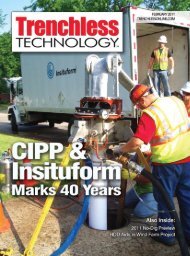Author: Professor, Dr. Dietrich Stein - TrenchlessOnline
Author: Professor, Dr. Dietrich Stein - TrenchlessOnline
Author: Professor, Dr. Dietrich Stein - TrenchlessOnline
You also want an ePaper? Increase the reach of your titles
YUMPU automatically turns print PDFs into web optimized ePapers that Google loves.
POINT OF VIEW<br />
The Importance of<br />
Subsurface Investigations in<br />
New Trenchless Installations<br />
It is said that when it comes to<br />
underground construction, the<br />
owner owns the ground and the<br />
contractor owns the means and<br />
methods. This ultimately means that<br />
the owner (in conjunction with the<br />
designer) is responsible for providing<br />
sufficient information on the subsurface<br />
conditions so that the contractor<br />
can have a reasonable chance of constructing<br />
the new underground facility<br />
as desired by the owner at a fair<br />
price.<br />
Without a sufficient understanding<br />
of the subsurface conditions, the contractor<br />
is at risk of failing to complete<br />
the construction based on the construction<br />
methods that the contractor<br />
planned and priced its work on,<br />
and the owner risks additional costs<br />
and delays due to change orders<br />
resulting from differing conditions. In<br />
other words, the owner is responsible<br />
for providing biddable contract<br />
documents with sufficient subsurface<br />
information so that the contractor<br />
can anticipate the ground conditions<br />
and select the proper procedures,<br />
equipment and tooling.<br />
In the case of microtunneling, the<br />
contractor will need to have an<br />
understanding of the subsurface conditions<br />
so that the configuration and<br />
tooling of the microtunnel head<br />
most appropriate for the ground conditions<br />
can be selected, production<br />
rates can be anticipated and handling<br />
and disposal of excavated material<br />
can be determined.In the case of horizontal<br />
directional drilling, the contractor<br />
needs to estimate production<br />
rates, in addition to determining<br />
potential drill mud lost rates, the<br />
potential for inadvertent surface<br />
returns (frac-out), and again, handling<br />
and disposal methods for the spoil.As<br />
can be seen, the subsurface information<br />
provided by the owner is key for<br />
the contractor to plan his means and<br />
methods and pricing.<br />
Knowing the underground subsurface<br />
conditions, also allows the contractor<br />
to better anticipate ground<br />
lost or subsidence and/or ground<br />
heave based on the anticipated<br />
behavior of the ground based on the<br />
planned construction method.<br />
Nothing ruins an owner’s and contractor’s<br />
day more than having unanticipated<br />
earth movement that causes<br />
surface settlement or heave, having<br />
other utilities move and possibly<br />
break, or perhaps worst, damaging a<br />
nearby structure or building.<br />
Not only should the owner<br />
provide the contractor with<br />
sufficient subsurface information,<br />
the owner should also consider<br />
using a geotechnical baseline<br />
report (GBR).<br />
In addition to pricing the work,<br />
both the owner and the contractor<br />
are at risk due to unknown subsurface<br />
conditions such as large boulders,<br />
buried former building foundations<br />
and contaminated soils and<br />
groundwater. The key word here is<br />
“unknown.” They are obviously<br />
unknown until discovered. However,<br />
to limit claims due to changed conditions,<br />
it is better for all if the owner<br />
can discover such conditions and<br />
owners reduce the amount of<br />
unknowns during the planning and<br />
engineering phase rather than to<br />
have the contractor discover<br />
unknowns during construction.<br />
Discovering the unknowns during<br />
the planning and engineering phase<br />
allows the owner to mitigate the<br />
issues associated with the unknowns<br />
such as handling and disposal of contaminated<br />
soils, changing the vertical<br />
and/or horizontal alignment of the<br />
proposed pipeline to avoid obstructions<br />
and/or locating jacking and<br />
receiving shafts at locations of the<br />
previously unknown obstruction to<br />
avoid installing one there later as the<br />
infamously known “911” hole.<br />
Without a sufficient understanding<br />
of the subsurface conditions, the con-<br />
By<br />
Dennis J. Doherty, P.E.<br />
tractor often needs<br />
to make a number of assumptions on<br />
the subsurface conditions and evaluate<br />
the risk associated with the<br />
assumed underground subsurface<br />
conditions. These assumptions<br />
include conditions that will affect<br />
production rates, methods of controlling<br />
groundwater and earth movement,<br />
construction methods and<br />
potential risk for failure of the construction<br />
method. The risk of failure<br />
is the greatest unknown and could be<br />
costly and potentially economically<br />
devastating to the contractor.<br />
To account for the potential risk, a<br />
contractor may increase his bid price<br />
to cover contingency in case the<br />
unknown subsurface conditions do<br />
in fact affect his production rates and<br />
thus labor and rental cost. In other<br />
words, he is passing the cost of the<br />
risk on to the owner. If the contractor’s<br />
assumptions are correct, the<br />
money not used for the contingency<br />
becomes a windfall for the contractor<br />
and the owner does not get a fair<br />
price for the installed work.<br />
Therefore, it is in the interest of the<br />
owner to provide as much information<br />
on the subsurface conditions as<br />
possible to minimize the assumptions<br />
and guessing that the contractor is<br />
forced to use when pricing the project.This<br />
generally results in lower bid<br />
prices by the contractors.<br />
Not only should the owner provide<br />
the contractor with sufficient subsurface<br />
information, the owner should<br />
also consider using a geotechnical<br />
baseline report (GBR). The GBR is a<br />
risk sharing tool, allowing both the<br />
owner and contractor to share in the<br />
risk. It helps allocate the risk of<br />
underground construction to those<br />
best able to handle the risk.As noted<br />
above, the owner owns the ground<br />
and the contractor owns the means<br />
and methods. Sharing the risk is in<br />
the best interest of all parties.<br />
Dennis J. Doherty, P.E., is senior project<br />
manager-trenchless technologies<br />
at Jacobs Engineering Group Inc.<br />
66 TRENCHLESS TECHNOLOGY September 2007 www.trenchlessonline.com








